 |
| Bulgarian Carrot Pepper |
As you know, Megan and I planted fifteen pepper plants; four Shepherd, five Bulgarian Carrot, and six Jimmy Nardello. They have all grown and developed leaves and some are even producing their first blossoms! Surprisingly though, it is our Bulgarian Peppers starting with the blossoms. I thought it would be the Shepherds that produced blossoms first because they were store bought and much more developed than the Bulgarian Carrots or Jimmy Nardellos that we started from seed. The blossoms are not visible in the pictures yet though.
 |
| Yellow Pear Tomato |
Tomato-wise, things have changed a lot, as they have certainly doubled in size, maybe even tripled! Megan and I have noticed little blossoms starting on these too, although they are not entirely visible yet. I'm hoping to see some tomatoes form on these soon. They must be loving this hot weather!
 |
| Musquee de Provence |
I love the looks of our pumpkins! Megan put a few more seeds in the mounds along with the plants we started indoors, because last year some of our plants mysteriously disappeared. Maybe we can get more than two pumpkins this year.
 |
| Cherokee Trail of Tears Bean |
Our Cherokee Trail of Tears Beans are growing so large that I think the bamboo stakes we placed beside them won't be enough to hold them. We'll have to remedy this issue soon, maybe with some wire.
Jennifer




















